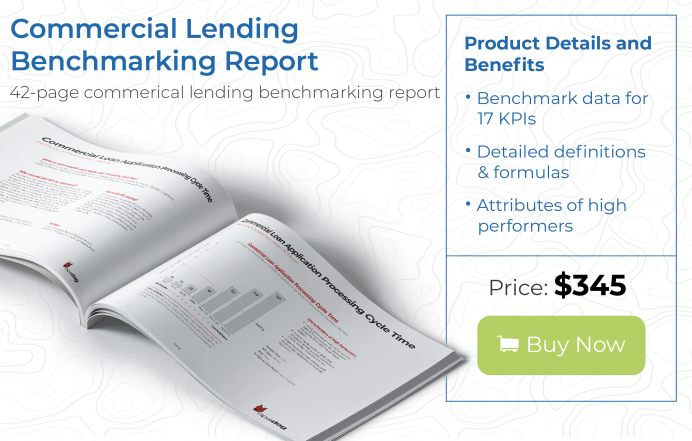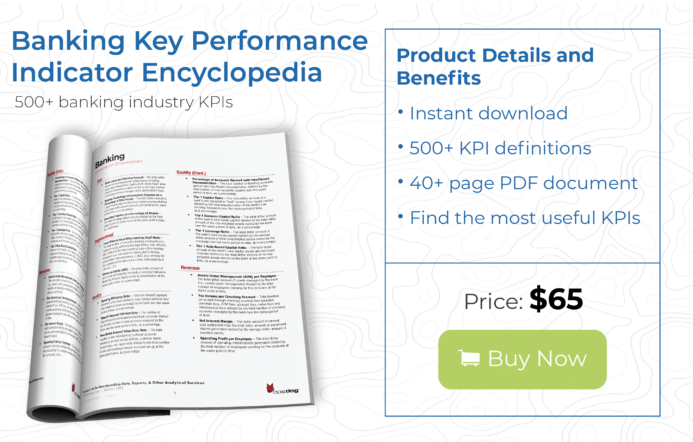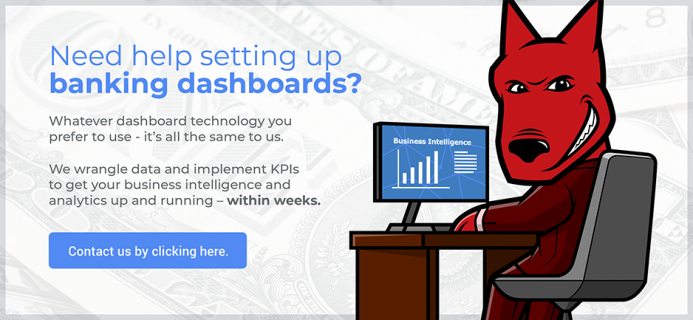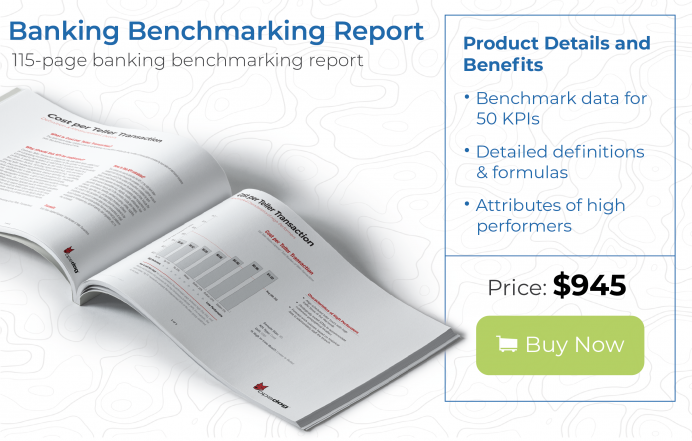Even with technology advances and automated processes, bank productivity and efficiency can lag. For example, according to the Mortgage Bankers Association (MBA), mortgage loan production expenses for banks actually increased to $9,299 per loan in the first quarter of 2019, and productivity remained unchanged at 1.8 loans originated per production employee per month.
While banks typically have a lot of data, they lack the ability to drill down into their banking operations and measure performance, cost effectiveness, customer service, efficiency, and more. This lack of insight can be crippling for a bank since they don’t even realize that making changes to processes can increase revenues, attract and retain customers, meet regulatory requirements, and allow them to compete against fintechs and other disrupters to the banking industry.
Business intelligence (BI) tools for banks can be used to remedy any operational dysfunctions. Below we will define and give examples of the various BI tools that can help your bank to run even more smoothly.
What is Business Intelligence in Banking?
Business intelligence tools for banks can be defined as tools, or systems, that take the data that institutions already have, aggregate it, analyze it, and then present it in an easy-to-understand format, such as dashboards. Business intelligence doesn’t just collect data but enriches that data to make it more useful for decision-making.
Armed with this intelligence, banks can realize a swathe of benefits. Business intelligence allows the bank to quantify specific operational goals and objectives, and then hold the bank accountable to meeting those goals.
Banks, partly due to regulatory scrutiny and partly due to the nature of their industry, have a good handle on financial gauges such as operating expenses, assets under management and return on equity. While these overall financial metrics are critical, they are just one indicator of how well a bank performs and how efficient its processes are.
For instance, the commercial lending business may be exceeding its stated revenue goals, but it’s not obvious if all departments are pulling their own weight. Are there functions within commercial lending that are actually dragging down revenue and, if brought up to speed, would boost revenue even more? Business intelligence tools for banks tell the story within the story—and most importantly—highlight areas of potential improvement.
Often, banks can make changes based on business intelligence that are relatively quick and inexpensive. Banks can often achieve significant results through more effective employee training to reduce errors, better prioritizing of work tasks, or updating how they measure customer satisfaction. These incremental improvements add up and translate into larger profit margins, higher customer retention, and even improved employee morale.
How to Implement Business Intelligence in Banking
Since business intelligence tools for banks rely first and foremost on data, the first step in implementing business intelligence is to ensure that the data from both internal and external sources is clean.
Once the data is clean, the next step is to clearly define the goals for business intelligence. What do you want to measure and improve? Perhaps you want to measure productivity in your retail lending area or how efficient your back office trading operations are. Focus on one specific goal to start. Don’t try to boil the ocean.
You’ll need a way to deliver that business intelligence to executives, managers and other decision-makers in a simple, easy-to-digest fashion. A dashboard, either developed internally or with the help of an outside partner, displays metrics and key performance indicators (KPIs) on a single screen.
Examples of Using Business Intelligence Tools in Banking
The options for how to apply business intelligence for banks are practically limitless and there are an extensive variety of BI tools available, including benchmarks and dashboards. Below are a few of the most widely used tools for business intelligence for banks:
Business Intelligence Tool #1: Consumer Loans Closed per Consumer Lending Employee
Comparing the total number of consumer loans closed to the number of consumer loan officers, loan processors, underwriters and closers gives banks an understanding of how efficient their consumer loan process is.
This metric provides important data that banks can use to remedy staffing issues or fix redundant steps in the workflow cycle. A low number of loans closed per employee can indicate that a bank has too many employees or employees who are not well-trained. It can also indicate manual processes or lots of loan application errors.
Business Intelligence Tool #2: Commercial Loans Outstanding per Loan Servicing Employee
Commercial loans outstanding per loan servicing employee is an indicator of bank strength. The most financially healthy banks tend to have a high ratio of total dollar amount of unpaid, interest-bearing commercial loan balances compared to the number of loan servicing employees—assuming the quality of the outstanding loans is high. This metric does not include non-performing loans.
Keeping an eye on this metric with BI tools is imperative to maximizing loan officer performance. Conducting periodic time studies can determine the allocation of loan officers time, which allows for relationship-building time and maximizes prospecting.
Business Intelligence Tool #3: Percent of Mortgage Loans Abandoned by Borrower
If, after the bank approves the loan, borrowers become frustrated with the lending process or find a more attractive loan at another institution, the bank not only loses revenue, but has incurred costs to process the application. Percent of mortgage loans abandoned by borrower is the number of mortgage applications approved but not accepted or withdrawn by the borrower divided by the total number of total mortgage loan applications approved, calculated as a percentage.
Used with your other BI tools this metric can help pin point problem areas in the mortgage loan process from start to finish. A high value might point to a lack of transparency, disagreements over loan conditions, inefficiencies within the review process, or sub-par underwriter training.
Business Intelligence Tool #4: Mortgage Application Approval Rate
Including this metric in your business intelligence dashboard will track the number of mortgage loans that have been submitted and approved, compared to the number of applications that have been received.
Banks only make money by approving and funding mortgages. Several factors can cause a bank to decline a high percentage of applications. Perhaps the borrowers are declined because they are risky, which could indicate that the bank is not attracting borrowers that fit its risk profile. Or, it could indicate that the application review and approval process is inefficient due to manual tasks, lack of staff training, or unfinished applications. To calculate mortgage application approval rate, divide the total number of approved mortgage loans by the number of applications submitted, calculated as a percentage.
Business Intelligence Tool #5: Cost per Equity Trade
A measure of back office operational efficiency, cost per equity trade is the total cost of processing equity trades divided by the total number of trades processed. This is important data for business intelligence tools for banks as it measures the operational efficiency of the equity trade process.
Unlike other metrics listed above, this data pertains solely to the back office operations of a bank. Back office costs include labor, overhead and technology. This metric only measures trading costs and does not include trade initiation, delivery, risk management or order routing.
Final Thoughts
Business intelligence tools can provide important insights into how your bank performs—and highlight those areas that need improvement. As you make changes to processes, employee training, rethink budgets or tweak a host of other levers, use business intelligence tools to measure and track those results.
Do you need help harnessing business intelligence (BI) for your bank? Find out how to see into operations data within a few months here!
Curious to learn even more about business intelligence tools for banks? Ready to harness the power of banking analytics? Contact us for data wrangling and to get your business intelligence and dashboards up and running within weeks.





